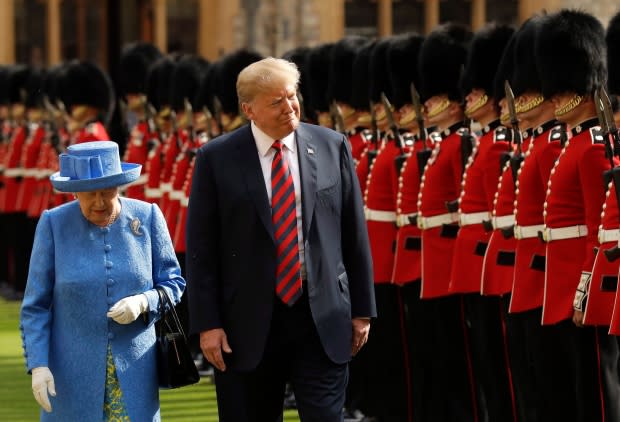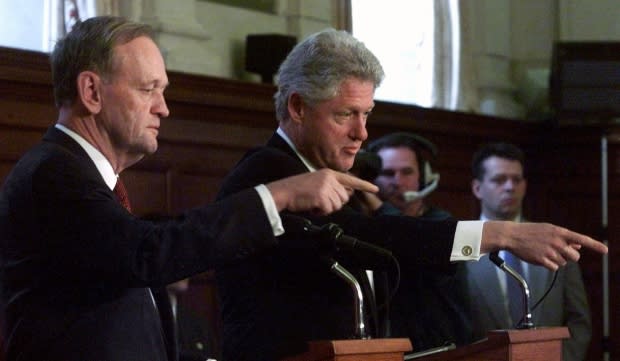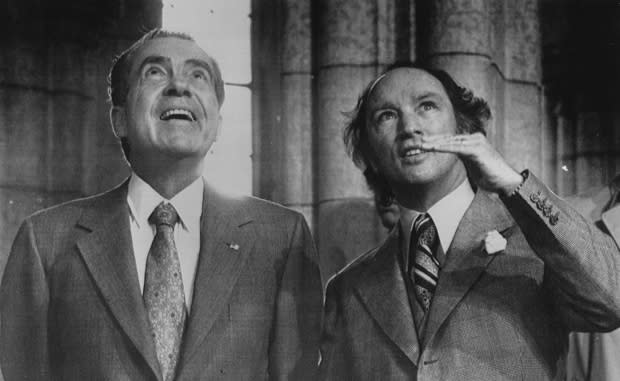Mike Pence is coming to Ottawa — but why hasn't Trump made a state visit to Canada yet?
U.S. Vice-President Mike Pence is coming to Canada next week to meet Prime Minister Justin Trudeau to discuss what the U.S. Embassy calls the "swift adoption" of the new NAFTA — but there's no sign of President Donald Trump planning a similar visit north of the border.
Trump is, instead, set to embark on a state visit to the United Kingdom in June, his second visit there as U.S. president.
Canada seems to be much lower on POTUS's travel do-to list. Trump has ventured north of the border only briefly to visit his country's closest ally and largest trading partner, and did so much later in his term than his recent predecessors.
Trump went to the U.K. in July 2018 on a working visit to meet British Prime Minister Theresa May and Queen Elizabeth II. His upcoming trip follows on an invitation first extended shortly after he took office in 2017.
Prime Minister Justin Trudeau extended just such an invitation to Trump early in the president's mandate. Trump hasn't said yes yet.
That tardy RSVP breaks with recent tradition. From Ronald Reagan to Barack Obama, recent U.S. presidents have established a loose practice of making Canada the first or second foreign country they visit after being elected for the first time.
Obama, George H.W. Bush and Bill Clinton all made Canada their first foreign stop upon taking office, while Reagan and George W. Bush made it their second.
Every American presidential visit to Canada is different. Some are cast as working trips, others are planned as official or state affairs, and sometimes the trip north occurs when Canada just happens to be hosting an international summit.
A state visit is the most formal type of presidential visit. It typically includes a meeting with the Governor General, a state dinner, military honours and the planting of a ceremonial tree at Rideau Hall.
An official visit is one step down from a state visit on the formality front. It's generally what happens when a president comes to Canada at the invitation of the government, and typically includes military honours.

On working visits, the president is hosted by the prime minister; such occasions involve no military honours or other ceremonial displays.
Trump paid a working visit to Canada last year: the president arrived June 8 and left the following morning after attending the G7 summit in La Malbaie, Que.
Trump's attendance at the meeting did little for Canada U.S. relations. The day before Trump flew into Quebec — and shortly after his administration extended controversial steel and aluminum tariffs to cover exports from Canada, Mexico and the European Union — he described Trudeau on Twitter as "being so indignant" in talking up Canada-U.S. relations without mentioning Canada's dairy quotas.
After a day of meetings that extended late into the night, Trump left the summit the next day, June 9, to fly to Singapore for a summit with North Korean leader Kim Jong-un. Once aboard Air Force One, Trump tweeted that he was instructing his officials to withdraw support for the summit's closing communiqué.

Trump's visit to Canada was a diplomatic train wreck. It also broke with recent tradition; Canada was not the first, or even the second country Trump visited after being elected, but the 17th. And the visit came almost a year and a half into his mandate.
"It's a gesture, but maybe the Canadian government is secretly relieved that Trump hasn't accepted the (formal) offer yet," said Roland Paris, associate professor of public and international affairs at the University of Ottawa. He was a foreign policy adviser to Trudeau before returning to academia in mid-2016.
"I think any Canadian government might be afraid of what might come out of his mouth.
"The government has not forgotten how Trump behaved at the G7 meeting, but I am sure that the invitation is genuine and that they would accommodate and welcome him were he to come."

Both Obama and Bush Sr. came to Canada for working visits a month after taking office. George W. Bush and Bill Clinton came for working visits three months after taking office, and Reagan went north for a state visit — and addressed Parliament — two months after taking office.
Look beyond recent presidential history, however, and it becomes clear that the tradition of presidents making Canada one of their first foreign destinations after taking office is neither absolute nor consistent.
In July, 1923, Warren Harding became the first U.S. president to visit Canada. It was his third and final trip abroad, taking place a little over two years after he assumed office.
Calvin Coolidge and Herbert C. Hoover didn't visit Canada at all. Dwight D. Eisenhower came to Canada in November, 1953, 10 months after becoming president; Canada was his third foreign trip. Harry S. Truman made Canada the sixth country he visited as president in July 1947.

John F. Kennedy, made Canada his first destination, travelling to Ottawa for a state visit and addressing Parliament four months after taking office in 1961.
Kennedy's successor, Lyndon B. Johnson, also made Canada his first foreign trip, travelling to Vancouver for informal meetings with Prime Minister Lester B. Pearson in September 1964, 10 months after his elevation to the presidency following Kennedy's assassination.
Canada was the 27th country that Richard Nixon visited. That visit, in April 1972, happened close to the end of his first term; the visit was a formal state affair that saw him address Parliament.
Presidents Jimmy Carter and Gerald Ford never visited Canada while serving as president.


